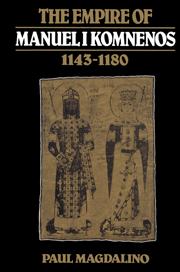Book contents
- Frontmatter
- Contents
- List of maps
- Preface and acknowledgements
- Note on transliteration and citation
- List of abbreviations
- 1 The empire, c. 1150
- 2 The heartland of the Comnenian empire
- Genealogical tables
- Introduction Problems and sources
- 1 The Comnenian empire between East and West
- 2 Constantinople and the provinces
- 3 The Comnenian system
- 4 Government
- 5 The guardians of Orthodoxy
- 6 The emperor and his image
- Epilogue
- Appendix 1 The poems of ‘Manganeios Prodromos’
- Appendix 2 Lay officials in synodal lists of the Comnenian period
- Appendix 3 Magnate ‘patrons’ under Manuel named in verse collections
- Bibliography
- Index
3 - The Comnenian system
Published online by Cambridge University Press: 18 December 2009
- Frontmatter
- Contents
- List of maps
- Preface and acknowledgements
- Note on transliteration and citation
- List of abbreviations
- 1 The empire, c. 1150
- 2 The heartland of the Comnenian empire
- Genealogical tables
- Introduction Problems and sources
- 1 The Comnenian empire between East and West
- 2 Constantinople and the provinces
- 3 The Comnenian system
- 4 Government
- 5 The guardians of Orthodoxy
- 6 The emperor and his image
- Epilogue
- Appendix 1 The poems of ‘Manganeios Prodromos’
- Appendix 2 Lay officials in synodal lists of the Comnenian period
- Appendix 3 Magnate ‘patrons’ under Manuel named in verse collections
- Bibliography
- Index
Summary
THE NEW HIERARCHY AND THE EMPEROR'S KIN
The male line of Comnenian emperors died out in 1185, but descendants of Alexios I continued to rule the Byzantine world until its political collapse in 1461. The dynastic system which Alexios inaugurated thus proved to be the most stable and enduring that Constantinople had ever known, despite the process of disintegration over which it presided, and for which it was indeed partly responsible. It lasted almost two centuries longer than the longest previous dynastic succession, that of the ‘Macedonian’ emperors (867-1056), and it was not interrupted by the reigns of unrelated ‘outsiders’ such as Romanos I, Nikephoros II, and John I had been. The secret of its success can readily be appreciated by comparing Alexios’ policies with those of Basil I, the founder of the Macedonian dynasty. Both men were usurpers who had to make strenuous efforts to justify their violent coups d'état, and to ensure the succession of their descendants. Both advertised their regimes as the beginnings of new eras of imperial revival, and tried to prove themselves at the same time more beneficent and more efficient than their predecessors. But the two usurpers differed markedly in their treatment of their numerous children and kinsmen. Basil designated three of his sons co-emperors, but dedicated the fourth to the priesthood, and enclosed his four daughters in a convent.
- Type
- Chapter
- Information
- The Empire of Manuel I Komnenos, 1143–1180 , pp. 180 - 227Publisher: Cambridge University PressPrint publication year: 1993



